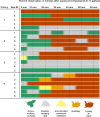Oral exposure to thiacloprid-based pesticide (Calypso SC480) causes physical poisoning symptoms and impairs the cognitive abilities of bumble bees
- PMID: 37020270
- PMCID: PMC10077645
- DOI: 10.1186/s12862-023-02111-3
Oral exposure to thiacloprid-based pesticide (Calypso SC480) causes physical poisoning symptoms and impairs the cognitive abilities of bumble bees
Abstract
Background: Pesticides are identified as one of the major reasons for the global pollinator decline. However, the sublethal effects of pesticide residue levels found in pollen and nectar on pollinators have been studied little. The aim of our research was to study whether oral exposure to the thiacloprid levels found in pollen and nectar affect the learning and long-term memory of bumble bees. We tested the effects of two exposure levels of thiacloprid-based pesticide (Calypso SC480) on buff-tailed bumble bee (Bombus terrestris) in laboratory utilizing a learning performance and memory tasks designed to be difficult enough to reveal large variations across the individuals.
Results: The lower exposure level of the thiacloprid-based pesticide impaired the bees' learning performance but not long-term memory compared to the untreated controls. The higher exposure level caused severe acute symptoms, due to which we were not able to test the learning and memory.
Conclusions: Our results show that oral exposure to a thiacloprid-based pesticide, calculated based on residue levels found in pollen and nectar, not only causes sublethal effects but also acute lethal effects on bumble bees. Our study underlines an urgent demand for better understanding of pesticide residues in the environment, and of the effects of those residue levels on pollinators. These findings fill the gap in the existing knowledge and help the scientific community and policymakers to enhance the sustainable use of pesticides.
Keywords: Associative learning; Bombus terrestris; Bumble bee; Insecticide exposure; Neonicotinoids; Pollinator; Sublethal effects.
© 2023. The Author(s).
Conflict of interest statement
The authors declare that they have no competing interest.
Figures



References
-
- Arce AN, David TI, Randall EL, Rodrigues AR, Colgan TJ, Wurm Y, Gill RJ. Impact of controlled neonicotinoid exposure on bumble bees in a realistic field setting. J Appl Ecol. 2017;54:1199–1208. doi: 10.1111/1365-2664.12792. - DOI
-
- Brittain C, Potts SG. The potential impacts of insecticides on the life-history traits of bees and the consequences for pollination. Basic Appl Ecol. 2011;12:321–331. doi: 10.1016/j.baae.2010.12.004. - DOI
-
- Brooks ME, Kristensen K, van Benthem KJ, Magnusson A, Berg CW, Nielsen A, Skaug HJ, Mächler M, Bolker BM. GlmmTMB balances speed and flexibility among packages for zero-inflated generalized linear mixed modeling. The R J. 2017;9:378–400. doi: 10.32614/RJ-2017-066. - DOI
Publication types
MeSH terms
Substances
LinkOut - more resources
Full Text Sources
Medical
Miscellaneous
